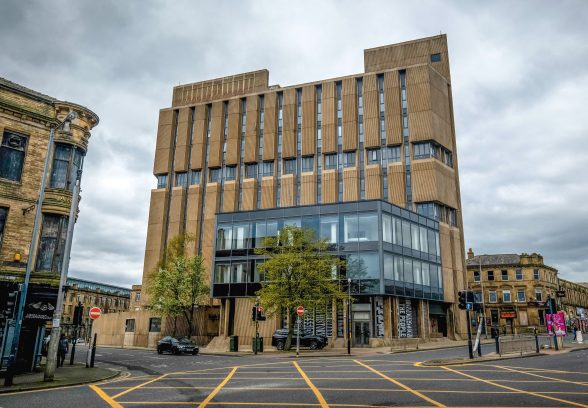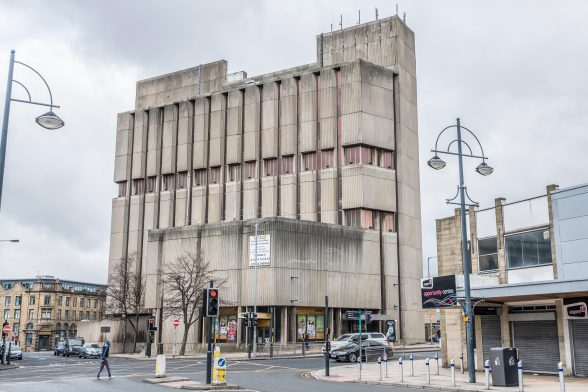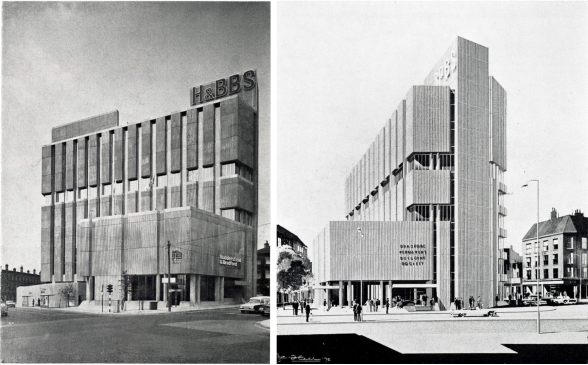This website uses cookies
This website uses cookies to enable it to function properly and to analyse how the website is used. Please click 'Close' to accept and continue using the website.



Image credit: Radii
After standing empty for more than 25 years and falling into a state of decay, the brutalist High Point building in Bradford, West Yorkshire, has been rehabilitated by a residential conversion scheme. Built in 1972 to designs by John Brunton Partnership as headquarters for the Huddersfield and Bradford Building Society, High Point was considered to be a ‘beacon of modernity’ in the mostly Victorian city centre, and remains one of the tallest buildings on the city skyline.
Locally based developer Radii and architects Beckwith Design Associates Ltd have accommodated 87 rental flats within the 8 storeys of former office space, supported by the award of a £2.9m Bradford Heritage Buildings grant by West Yorkshire Combined Authority, towards the total project cost of £11 million. The fluted concrete facade has mostly been retained and cleaned, with the horizontal and vertical bands of ribbon windows re-glazed throughout. The podium building has had its concrete facade panels replaced with curtain glazing, representing the biggest visual change to the building. Negotiations are currently ongoing with a potential cultural tenant to occupy this prominent space. Bradford will be UK City of Culture in 2025.

Image credit: Rob Ford
‘Utterly freakish’
Perhaps the most divisive building in Bradford, Pevsner witheringly described High Point as “an aggressive missile-silo-like office tower”, while Owen Hatherley, perhaps admiringly, thought it “utterly freakish, the severed head of some Japanese giant robot clad in a West Riding stone aggregate, glaring out at the city through blood red windows, the strangest urban artifact in a city which does not lack for architectural interest”. In the foyer of the building, a William Mitchell mural entitled ‘Bradford Old and New’ showcased notable local landmarks including City Hall, the Wool Exchange and The Alhambra.
Along with Halifax Building Society (BDP, 1968-74), which was Grade II listed in 2013, and Bradford & Bingley Building Society in Bingley (John Brunton Partnership, 1972-74), sadly demolished in 2015, the Society has argued the significance of this trilogy of northern building society headquarters, all in variants of high-brutalism.
“They represented (in retrospect, at least) the last-gasp of a sort of Heath-Wilsonian regional resurgence, at a time when “financial services” were not synonymous with the corporate casino-ism of the City of London, but a flourishing of century-old Victorian independent mutuals, and northern self-sufficiency.”

Image credit: Radii
Public Debate
In March 2018, C20 Society participated in a public debate hosted by Bradford Civic Society on the role of brutalism in the city centre, with a particular focus on the High Point building.
Entitled “Save High Point / Raze High Point”, the debate took place at Assembly Bradford, and was chaired by Dr George Sheeran, an author on Bradford’s architectural history and honorary visiting fellow at the University of Bradford. The panel was made up of Guardian journalist (and former C20 Chair) Sir Simon Jenkins, Catherine Croft, Director of C20 Society, Vijay Taheem, Bradford architect and senior lecturer at the University of Huddersfield’s School of Art Design and architecture, and Jordi Campo Bria, originally from Barcelona and who has been with Bradford-based Yeme architects.
Sir Simon Jenkins argued against saving the building, describing the brutalist style of High Point as “F – You” architecture, created by architects who were rebelling against previous generations, adding: “Those architects would never live in these buildings, or go near them, but to them it was a highly political statement to the world. Something has to be done with it. Most brutalist buildings are very difficult to re-use. You need someone very rich to look after it, otherwise it will stay there as a ruin.”
However, Catherine Croft said High Point was an important part of Bradford’s post war history, and should not be erased from the city’s skyline. She said: “There are lots of fabulous Victorian buildings in Bradford, but there are some great modern buildings that we need to preserve too. They show how cities have evolved. By trying to erase the legacy of brutalism you are simplifying the history of a city.”
Bradford architect Vijay Taheem said: “People regret that a lot of historic buildings in Bradford have been demolished. Would we be making the same mistakes by demolishing this building? By erasing something we might find unattractive now we might be taking something away from future generations.” At the conclusion of the debate, the audience voted conclusively to ‘save’ High Point. Some 6 years later, the retention and refurbishment of the building has brought this particular debate to a satisfactory conclusion.

Become a C20 member today and help save our modern design heritage.